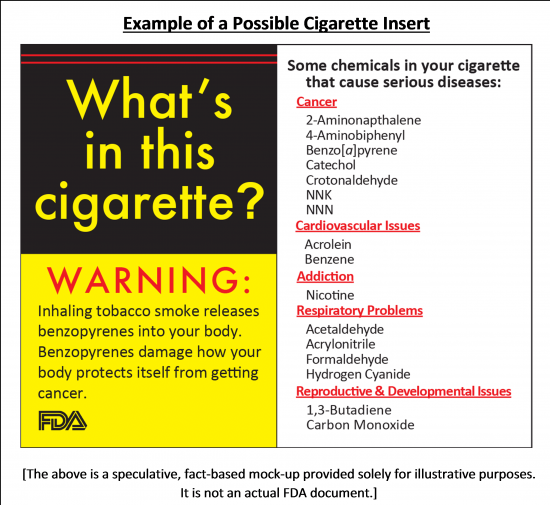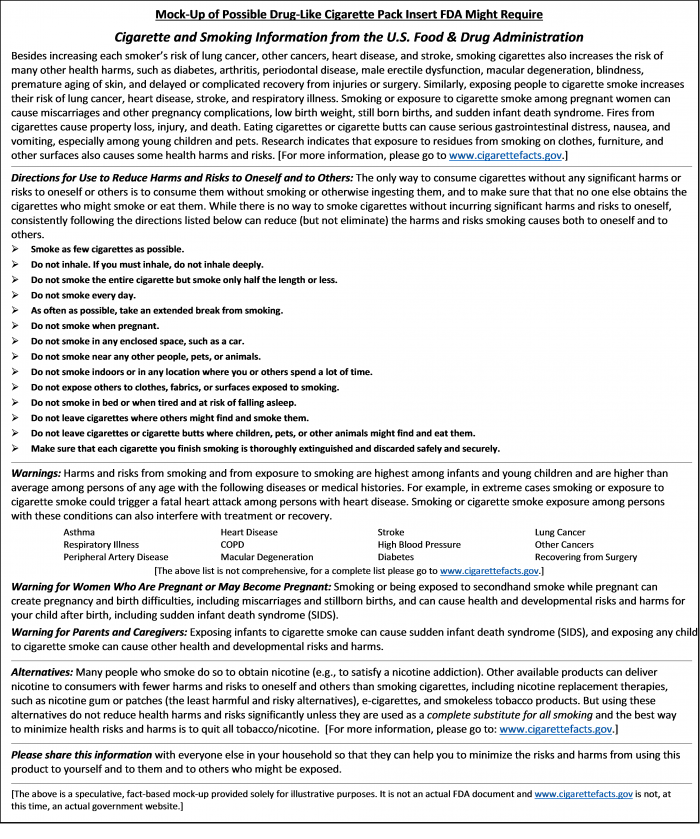Although the federal Tobacco Control Act gives the U.S. Food and Drug Agency extensive authorities to regulate tobacco products and their marketing, labeling, and sale, the Trump Administration’s new pro-business, anti-regulation approach might put some serious obstacles in the way of any significant new FDA regulations to reduce the massive amounts of tobacco use and harms still experienced in the USA.
But new informational tobacco product inserts or onserts to help consumers make more informed choices would fit well within the harm reduction and consumers’ right-to-choose approach to tobacco control that the major tobacco companies support and the new Trump Administration leadership will likely find most appealing. Done right, such informational leaflets placed in cigarette packs or temporarily affixed to the outside of the packs could also secure some significant public health gains. Even if were done wrong, the risks of significant harm would be minimal.

The industry-favored consumer right-to-choose approach to tobacco control gives top priority to ensuring that legal adult consumers may freely choose whether or not to use legally available tobacco products (no matter how harmful, deadly, and addictive the industry makes them). A harm reduction approach focuses specifically on making sure consumers are provided information about the relative-harmfulness of different types of tobacco products – e.g., so that users of those that are more harmful (e.g., cigarettes and other smoked tobacco products) may choose to switch to those that are less harmful (e.g., e-cigarettes).
Because a consumer-choice, harm-reduction approach to tobacco control uses market mechanisms, instead of government requirements or restrictions, it would be entirely consistent with the Trump Administration’s pro-business, anti-regulation ideology. Indeed, the new Trump Administration leadership might actively adopt this industry-favored approach in order to eliminate any consideration of more effective measures to reduce tobacco use — such as advertising and other marketing restrictions, regulations to make certain tobacco products less harmful or minimally addictive, or raising the minimum age to buy tobacco products.
Even if that is not done expressly, FDA’s best chance for getting permission from the new Trump Administration to issue any new tobacco control rules might be to propose new consumer-education requirements that would be entirely consistent with the consumer right-to-choose and harm reduction approaches – and require minimal new government or business expenditures.
How Might FDA Educate Consumers Under a Consumer-Choice, Harm-Reduction Approach?
While less directly effective than many other possible tobacco control measures, providing consumers with accurate relative-harm information would produce public health gains to the extent that it prompted ongoing users of more harmful tobacco products to switch entirely to using significantly less harmful tobacco products. But it would produce public health losses to the extent that it reduced or delayed total tobacco use cessation among current users, increased relapse into tobacco use among former users, or increased overall initiation into tobacco use.
Done right, such an effort would increase knowledge and understanding among the current users of the most harmful tobacco products about their options for reducing health harms and risks. Done wrong, it would confuse or mislead both users and nonusers into mistakenly acting in ways they think will reduce their health harms and risks but will actually increase them.
For example, a public education campaign that spread the word among all adults and youth that e-cigarettes are significantly less harmful than cigarettes could prompt some beneficial total switching from smoking to e-cigarette use. But, besides requiring considerable government spending, it could also encourage some adults and youth who would not otherwise ever try or use e-cigarettes to do so; prompt some former users to relapse into e-cigarette use; reduce quitting among e-cigarette users; and prompt some smokers who would otherwise have quit all tobacco and nicotine use to use e-cigarettes, instead, either alone or with continued smoking.
This problem of reaching the wrong audiences could be minimized by directing any relative-harm information about e-cigarettes or smokeless tobacco products only to smokers (the audience who could most benefit from that information). Perhaps the best way to do that would be to deliver the reduced-harm or relative-risk information with the cigarettes and other smoked products, themselves. That way, those who are already in possession of the cigarettes or other more harmful tobacco products would be the only ones who would directly see the harm-reduction information.
In contrast, new warning labels on e-cigarettes or new warnings on smokeless tobacco products which state that those products are significantly less-harmful than cigarettes would do little to reach smokers directly to encourage them switch to those less-harmful products. But they would directly reach current users and experimenters of the e-cigarettes or smokeless tobacco products, which could reduce related cessation and increase related initiation.
To better target this harm-reduction information just to current smokers, it could be delivered only through warning labels on cigarette packs. But cigarette warning labels are also seen by many non-smokers and former smokers because the same warnings required on cigarette packs are also required in cigarette ads and could be seen in images of cigarette packs used in cigarette signage and other ads. Much of this unhelpful exposure to the warning labels could be reduced by not permitting the relative-harm warnings to be used or shown in cigarette ads. But that would require new rules restricting business speech, which raises First Amendment issues and conflicts with a pro-business, anti-regulation approach. Moreover, even with such restrictions any reduced-harm warnings on packs could still be seen by the cigarette smokers’ children and other family members, friends, and colleagues.
In addition, warning labels cannot deliver very much information. For example, to prevent the relative-harm information from prompting smokers to act mistakenly against their best health interests, it should not only say that e-cigarettes are less harmful than cigarettes but should also include, at a minimum, all of the following relevant, accurate information.
- Switching entirely to using e-cigarettes instead of smoking can reduce health harms and significantly reduce health risks— but only if e-cigarettes are used as a total replacement for smoking (with no continued smoking of any significance).
- The best way for smokers to reduce health harms and risks is to quit all tobacco use and all nicotine use, altogether.
But it would be difficult for a warning label that fits on a cigarette pack to include all of that basic information legibly, much less provide any detail or explanation necessary to avoid confusing or misleading those who read it. Nor could a warning label include any additional “instructions for use” for those smokers who do not quit or switch so that they can reduce the harms and risks their continued smoking causes to themselves and to exposed others.
Using Tobacco Product Inserts and Onserts to Deliver Relative-Harm Information
Cigarette pack inserts or onserts, however, could provide all of this basic information plus additional detail, explanation, and complementary information – thereby reducing the risk that the provided information would mislead consumers into making decisions against their health interests. [See example, below, after end of text.]
Like warnings, inserts or onserts would also go directly only to those persons who buy or open packs of cigarettes, which is the desired harm-reduction audience of cigarette smokers and experimenters. But, unlike warnings, the inserts and the relative-harm contents of the onserts would not be seen by any nonsmokers or former smokers who saw cigarette packs on display or pictured in ads. Moreover, the more extensive information provided in the inserts or onserts would help to ensure that any nonsmokers or former smokers who saw their relative-risk contents would not be encouraged to initiate or relapse into using the less-harmful tobacco products (and the provided information would also work to reduce the likelihood that they might initiate or relapse into smoking).
The tobacco companies have used cigarette inserts and onserts for marketing purposes, and inserts and onserts for prescription and over-the-counter drugs are widely used for health-directed purposes. So far, however, the only country requiring public health inserts in cigarette packs is Canada. Three published studies of the Canadian inserts indicate that inserts and onserts can work independently or in tandem with warning labels to promote cessation – and should work just as well to promote switching to less-harmful tobacco/nicotine use or just to help consumers make more informed decisions about their tobacco product use.
As detailed in a recent publication in the Food and Drug Law Journal, the federal Tobacco Control Act gives FDA clear authority to require cigarette and other tobacco product inserts or onserts, and the First amendment constraints that might apply to any such inserts or onserts are considerably less restrictive than those that could apply to warning labels on cigarette packs or in cigarette ads. FDA could readily develop and implement a new rule to require cigarette and other tobacco product inserts and onserts without encountering any First Amendment obstacles, especially if the rule was designed only to inform consumers (without explicitly encouraging them to quit or switch).
Although other FDA tobacco control rules would be more directly effective at reducing tobacco use and harms, a new requirement that cigarettes and other smoked tobacco products include inserts or onserts that provide accurate relative-harm information about smoking versus e-cigarette use could be one of the most effective rules the Trump Administration might allow FDA to implement.
Because consumers could use the provided information as they saw fit, without any coercion, an insert-onsert rule would fit well within the kind of pro-market, consumer right-to-choose, harm-reduction approach the Trump Administration is likely to support for tobacco control.
The rule would also be a good fit for the pro-business and anti-regulation approach of the Trump Administration because it would not regulate the tobacco products, themselves, or their externally visible packaging. Nor would the rule restrict any tobacco industry advertising, marketing, or sales. Any related costs or burdens on the tobacco industry would be minimal; and, to the extent that smokers actually switched to less-harmful tobacco products in response to the inserts or onserts, the tobacco industry would not lose customers (but their customers would be harmed less). Moreover, the reductions in tobacco use harms prompted by the informational inserts or onserts encouraging switching and cessation would translate directly into corresponding increases to worker productivity and reductions to business smoking-caused costs, producing even more reasons why a perceptive Trump Administration should not just allow but encourage FDA to implement well-designed informational inserts or onserts for cigarettes and other smoked tobacco products.
Poorly designed inserts or onserts that produce unnecessary health harms are certainly possible. But the Tobacco Control Act and other applicable laws prohibit FDA from requiring tobacco product inserts that are false or misleading, and the Tobacco Control Act generally provides that FDA may require specific cigarette or other tobacco product inserts or onserts only if FDA reasonably determines — after reviewing all relevant available evidence, both pro and con – that the inserts or onserts are “appropriate for the protection of the public health.” These provisions should ensure that any FDA-required cigarette or other tobacco product inserts or onserts would work effectively to produce public health benefits – so long as the new Trump Administration leadership does not interfere with the FDA’s Center for Tobacco Products efforts to interpret and apply the public health standards constructively and so long as any efforts to weaken those standards in Congress are rejected.
It would also be possible for the states to require cigarette inserts or onserts, especially if FDA did not take any action in this area.




